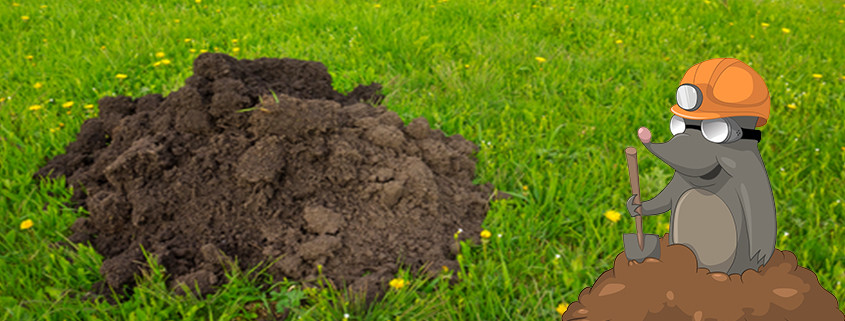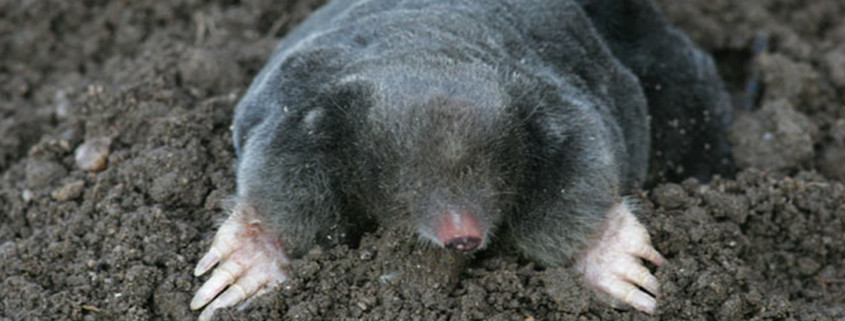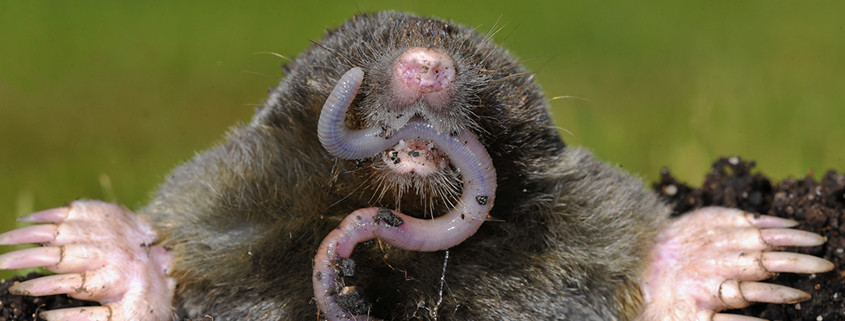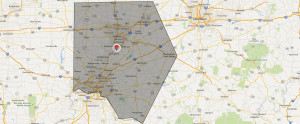Mole Control Dayton Ohio 763-307-4384
Feel Free to Call Us Anytime For a Wildlife Issue
For Issues With Stray cats or Free Roaming Dogs Contact:
Montgomery County Animal Resource Center (937) 898-4457
Mole removal in Dayton Ohio
A perfect smooth emerald-green lawn in front of the house is every homeowners dream. The dream of that beautiful lawn may be ruined by one significant villain. The MOLE! Moles were designed to be perfect diggers. They are able to dig as fast as 1 foot per minute. Their tunnels push up the sod and their digging habits may leave large unsightly mounds of earth on your meticulously manicured lawn. If you have noticed the first evidence of tunneling in your turf, and suspect a mole is the culprit, then mole control should be a high priority! It’s obviously better to get rid of these skilled diggers sooner rather than later.
How do I know if I need Ground Mole control?
What does mole damage look like?
Mole Damage: Moles excavate a network of connected chambers by burrowing. They dig tunnels deep in the soil (where mole damage goes unnoticed) and close to the surface (where mole control is effective). Mole damage can come in 3 types:
- Mole mounds are places where the mole has pushed earth up above the surface. This soil is typically from maintaining a deep tunnel.
- Traveling tunnels are long somewhat strait tunnels. These tunnels typically connect different food sources together. Yard mole control is most productive along these travel routes.
- Feeding areas/tunnels are found in locations that are rich in the moles food. Moles build new feeding tunnels constantly and may not use the same one twice.
Nuisance concerns: The primary problem with moles is the tunneling. They can leave raised travel tunnels across the lawn. They can also leave unsightly molehills. They are not dangerous, but they can ruin the aesthetics of your landscaping and lawn. It is wise to get rid of moles before they become well established.
Funny Mole Video
Mole Facts:
Moles live a fossorial (underground) life. They rarely if ever come to the surface. Moles are burrowing insectivores. Their cylindrical bodies grow to be 6 to 8 inches long and have gray to black velvety fur and powerful front claws are ideal for digging. They almost “swim” through the dirt. They have very poor sight and feed mainly on worms and insect larvae that they find with their sense of smell and touch. They have slender hairless snouts, and small eyes and ears. The moles’ large front feet have long stout claws built for digging. Except for breeding season in early spring, moles tend to live alone, so the multitude of mole damage in you yard is likely home to only a couple of moles. A good understanding of the moles lifecycle will help a mole control or lawn mole removal professional perform professional mole removal.
- A 5 ounce mole will consume 45-50 lbs of worms and insects each year.
- Moles can dig surface tunnels at approximately 18 feet/hour.
- Moles travel through existing tunnels at about 80 feet/minute.
- Moles contain twice as much blood and twice as much hemoglobin as other mammals of similar size. This allows moles to breathe more easily in underground environments with low oxygen.
There are six species of moles in North America. Three of these occur in our service area: the Eastern Mole, the Hairy-tailed Mole, and the Star-nosed Mole. The Eastern Mole (Scalopus aquaticus) is most common in Ohio. Moles are about the size of chipmunks and weigh three to six ounces. Each female mole can have one litter of two to six young per year. Gestation lasts about approx. 40 days. Which means litters are born from mid-April through May. A professional mole removal strategy will be framed around preventing mole reproduction. If ground moles are trapped early in the spring their reproduction is stopped.
What do moles eat?
Moles are insectivores (they eat insects). Mole activity can cause considerable damage to lawns. This damage is usually in the form of tunnels or mounds in lawn. These can be unsightly, disturb plant rooting systems, and provide cover or travel lanes for other voles, shrews and mice.
Why are my plants dying?
Moles eat insects and insect larvae, but their favorite foods include worms and grubs. Moles do not eat plants. If you have noticed your plants have perished chances are it’s not from mole damage. Voles and rodents will commonly use the moles tunnel to travel and they will feed on plant roots. Moles may inadvertently loosen or remove soil from around a plants roots preventing the plant from absorbing nutrients and moisture from the soil. If your plants are uprooted or have fallen over from loose soil or buried under fresh earth, then you probably need yard mole removal.
Why is there mole damage in my yard?
Given their choice, moles prefer moist, sandy loam soils. opposed to dry, heavy clay soils. They are most active during warm, wet months, although they live underground all year. Moles like lawns because the soil is often light and moist. Worms and grubs prosper in manicured lawns. This food resource is why the mole is there. The mole will continue to tunnel as long as it can find a steady food supply. It is common for a new mole to move into another moles abandoned tunnel. The type of soil in your yard will dictate what type of mole trap is best suited for a professional mole removal strategy. In larger lawns mole activity may move from one place to another. This movement is dictated by temperature and ground moisture. Moles respond to changes in food supply. When different insect larvae become available in different locations throughout the year. Mole activity may last only a week or two in a particular area. This here-today, gone-tomorrow behavior is why most home remedies and pesticides appear credible. A professional lawn mole control strategy will be centered on a sound mole trapping system.
What others have to say about us
If your in need of a professional wildlife company who utilizes professional humane methods to remove wildlife look no further. Chris operates with professional methods and is fully capable of mitigating your issues. I recommend you give him the opportunity to assist you.
What a great company! Having a wildlife issue can be intimidating but not if you have the right company. Advantage is a great company and Chris is extremely knowledgeable and professional. Please don’t hesitate to give these guys a call if you have any issues with wildlife.
Check us out on Facebook
Don’t forget to “Like” us while you are there.
How to get rid of moles
How do I get rid of moles?
If you are like most, you’re probably confused by all of the conflicting “advice” on yard mole removal. You may believe every rumor, old wives tail, or home remedy, or lawn mole removal method has merit. If not handled properly a small mole issue can quickly colonize and spread through adjacent residential properties. Many times people waste valuable time and money attempting unproven mole control tactics. If professional mole removal had been tried first, the mole damage could have been reduced.
Mole Repellent-
Some old wives’ tales recommend using mothballs, ammonia, bubble gum, and even broken glass. As a professional mole trapper I’ve been to countless homes where these techniques have failed. To date there have been no scientific studies proving any mole repellent actually repels moles. Moth balls are commonly attempted method of mole control. Some companies sell sprays to get rid of moles, but these are ineffective at removing moles. There is no spray or device that will successfully get rid of moles. There is no such thing as an effective mole repellent. Wondering how to get rid of moles in your lawn? The only consistent way to get rid of a mole is to use a mole trap. Mole repellant, mole poisons, mole fumigants, and home remedies are less effective. If you want to get rid of moles in your lawn efficiently, you need to have a professional mole removal service assist you.
Scare Tactics-
Over the years numerous home remedies have been used. Results are inconsistent and generally ineffective. Remedies such as moth balls, pickle juice, hair balls, broken glass, red pepper, razor blades, bleach, rose branches, vibrators, ultrasonic devices, castor oil, and explosives have been used. These attempts at lawn mole removal may relieve frustrations, but they have little value in mole control. Furthermore, certain chemicals or explosives are illegal to use. Ultrasonic sound emitters are available as well. These devices are worthless at eliminating moles. The ONE AND ONLY WAY to take care of a mole infestation is with mole trapping and yard mole removal. If you’re not experienced with mole trapping contact a local company who offers professional mole removal.
Mole Trapping-
Trapping is by far the most effective and practical means of mole control. Trapping success is best in the spring and fall. In the summer and winter, moles are active deeper in the soil and more difficult to trap. Below and above ground traps are available for getting rid of moles. The 3 most common style of mole traps are: harpoon, scissor-jaw, and choker loop. To ensure safe deployment, be sure to follow the manufacturer’s instructions. Moles can be very difficult to trap. Their time spent in the soil and their tendency to abandon tunnels can lead to mole trapping frustration. Traps should be placed in active mole tunnels and are checked regularly to get rid of moles.
Can I trap the moles myself?
The only proven way to remove moles is to trap them. Mole trapping requires experience with mole traps and mole behavior knowledge. When used incorrectly mole traps can be dangerous. Mole trapping is often a situation that is best left to a professional. Many home owners attempt to yard mole removal themselves and wind up frustrated and defeated by the mole. Placing a quality mole trap in an active tunnel is the best way to get rid of moles. There are many varieties of mole traps. Trapping moles can be an effective method of ground mole removal if done properly. Knowing how to trap a mole takes experience and practice. If you are going to attempt to trap a mole yourself, you will need to purchase quality mole traps and set them per the manufacturer’s directions.
Professional Mole Control
Moles are subterranean animals which make yard mole removal difficult. To control moles, a professional will easily be able to determine if mole tunnels are active or inactive. Traps will then be placed in the most active tunnels. It takes experience to find the key locations to set mole traps. Trapping moles can be extremely difficult, and mole traps must be set precisely or they will not catch moles. The mole traps must be secure and stable. The mole trap location will be marked. The mole traps will be checked regularly by a professional mole removal service. This mole trapping knowledge is gained through years of experience, which is why hiring a professional for mole control may be the best idea.
Link to our Service area map
Check our reviews
We proudly provide mole removal service to the following communities:
Greene County Ohio mole removal.
Bath Township. Beavercreek mole control expert. Beavercreek Township. Mole control in Bellbrook. Bowersville. Byron. Caesarcreek Township. Mole control in Cedarville. Cedarville Township. Centerville expert mole control service. Clifton. Mole control in Fairborn. Huber Heights Mole control experts. Jamestown. Jefferson Township. Mole control in Kettering. Miami Township. New Jasper Township. Oldtown. Ross Township. Shawnee Hills. Silvercreek Township. Spring Valley mole control professional. Spring Valley Township. Sugarcreek Township. Wilberforce. Mole control in Xenia. Xenia Township. Yellow Springs.
Montgomery County Ohio mole removal.
Brookville. Butler Township. Mole control in Centerville. Clay Township. Clayton. Dayton. Englewood. Farmersville. Germantown mole control professionals. German Township. Harrison Township. Huber Heights mole control experts. Jackson Township. Jefferson Township. Mole control in Kettering. Mole control in Miamisburg. Miami Township. Moraine. New Lebanon. Northridge. Oakwood. Perry Township. Phillipsburg. Riverside. Trotwood. Union. Vandalia. Verona. Washington Township. West Carrolton.
Warren County Ohio mole removal.
Blanchester. Butlerville. Carlisle. Clearcreek Township. Corwin. Deerfield Township. Franklin. Franklin Township. Hamilton Township. Harlan Township. Harveysburg. Lebanon. Loveland. Maineville. Mason. Massie Township. Middletown. Monroe. Morrow. Pleasant Plain. Salem Township. South Lebanon. Springboro. Turtlecreek Township. Union Township. Washington Township. Wayne Township. Waynesville.








